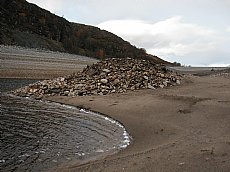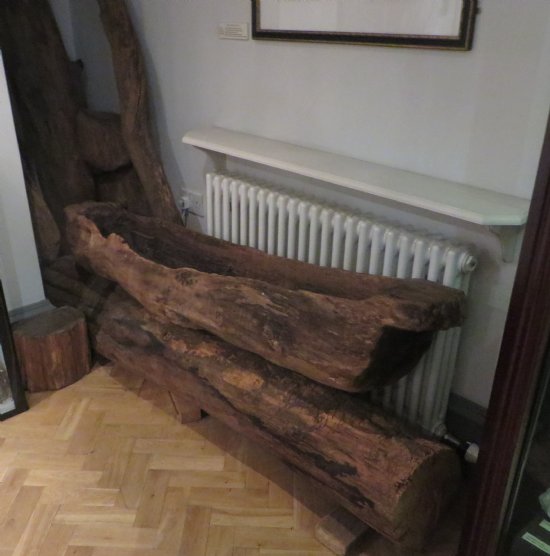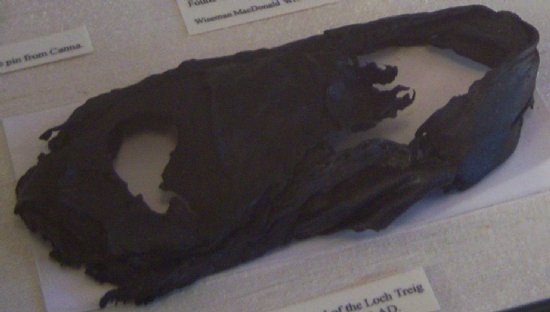Eaderloch Crannog, Loch Treig
01 May 2019
- News Type:
- Site of the Month

Eadarloch crannog is located in a shallow loch between the River Treig and Loch Treig, Lochaber. It was first excavated in 1933 by James Ritchie, when the loch was temporarily drained during operations involving the Lochaber Water Power Scheme. This revealed a structure which comprised a rectangular framework of undressed logs secured together by pegged half-check joints and fixed in position by piles. There was no clear evidence of a superstructure apart from a large, central posthole, although a series of superimposed hearths were also discovered.

Artefacts from the excavations included a fragment of an iron backsword, portions of leather shoes, a fragment of wool fabric, bronze tweezers, hand-forged nails, a fragment of a knife, sherds of an earthenware jar, a bronze circular brooch and a silver coin of Mary Queen of Scots (c. 1542-58). Two wooden objects, possibly a log boat and a trough, were also found in the vicinity of the island and were likely to be associated with the crannog. The excavated finds suggested that the crannog had been in use in the late 16th and early 17th centuries, although no evidence for the construction of the crannog was discovered during Ritchie’s excavations.

The crannog was revisited in 2007 by AOC Archaeology Group, who undertook a topographic survey of the crannog, when low water levels of the loch provided an opportunity where it was suitably exposed. Very little of the crannog was found to have survived: only the primary foundations of the crannog, remains of the timber lattice of undressed logs and an arc of piles along the western edge of the crannog. Sampling of the timbers was also undertaken, as part of a wider project to develop tree-ring chronologies of native pine and oak for Scotland. Dendrochronological analysis, however, proved inconclusive and samples were submitted for radiocarbon dating which returned three dates between the late 15th century and early 17th century (AD 1480-1650, calibrated at 2 sigma).
In light of the radiocarbon dates, the construction of the crannog can be seen as representative of 16th century rustic workmanship. The crannog was rectangular, with crude joinery, indicating that it was rapidly put up, and likely built for a specific purpose. Local oral and written sources may provide a clue as to this purpose; a traditional name applied to the site is Eilean Ruighe na Slighe, which translates ‘the island of the shieling of the track’. Given that the crannog lies just to the north of a sand spit dividing Eadarloch from Loch Treig, and forms a crossing point for the track running from Rannoch to Glen Spean, it is possible that the crannog was built as a refuge for travellers across this route. The crannog also features in a poem written by the famous Gaelic poet, Donald Mackinlay, c. 1600 which refers to the crannog as Tigh nam Fleadh, or ‘House of Feasts’, which possibly refers to the seasonal use of islands as hunting lodges by chiefs and their retinues. The crannog was also known as ‘Keppoch’s Council Island’, a reference to the tradition that the Chief of Keppoch used to meet his clansmen there when in hiding in the early 17th century. Both names imply that the site played an important part in the role of the exercise of chieftainship, and may have fallen out of use in the 17th century due to the wider changes of the organisation of Gaelic society.
The radiocarbon dates, finds and written and oral traditions relating to Eadarloch crannog all point to a post-medieval date for its construction and use. Crannogs are most commonly thought of as Iron Age structures, with archaeological evidence also indicating that they were used in the early medieval period. In Crone’s 2012 publication, 159 radiocarbon dates from 52 crannog sites across Scotland are listed, and of these, the vast majority comprises Iron Age and early medieval dates. There is cartographic and documentary evidence of the use of crannogs in the late-medieval and post-medieval periods, but without archaeological work to accompany this, it is not possible to know how many of these sites were constructed exclusively in this period, and how many were reusing earlier sites. Eadarloch crannog, therefore, is a very significant site as it is the only example that can be pointed to as a truly post-medieval crannog, and is the most recently constructed in Scotland.
Further Information
https://her.highland.gov.uk/monument/MHG4296
https://canmore.org.uk/site/23904/eilean-tigh-na-slige
Crone, A. 2012. Forging a chronology for Scottish crannogs; the radiocarbon and dendrochronological evidence’, in Midgley, M S & Sanders, J (eds) 2012. Lake Dwellings after Robert Munro. Proceedings of the Munro International Seminar: Dwellings of Europe 22nd and 23rd October 2010 University of Edinburgh, 139–68. Leiden: Sidestone Press.
Report supplied by Grace Woolmer
Site of the Month Archive
- 10/04/2021 Easter Raitts township
- 02/03/2021 Lower Slackbuie, Inverness (ASDA) Neolithic site
- 01/02/2021 Balnuaran of Clava cairns
- 04/01/2021 Wilkhouse Inn
- 02/12/2020 Spinningdale Cotton Mill
- 02/11/2020 Skibo A Canadian Forestry Camp
- 01/10/2020 WWI Detonator Store, Dalmore near Invergordon
- 03/09/2020 Mesolithic Shell Midden at Sand, Wester Ross
- 08/08/2020 Kinbeachie Neolithic settlement
- 01/07/2020 Armadale Cist Burial and Stone & Timber Complex
